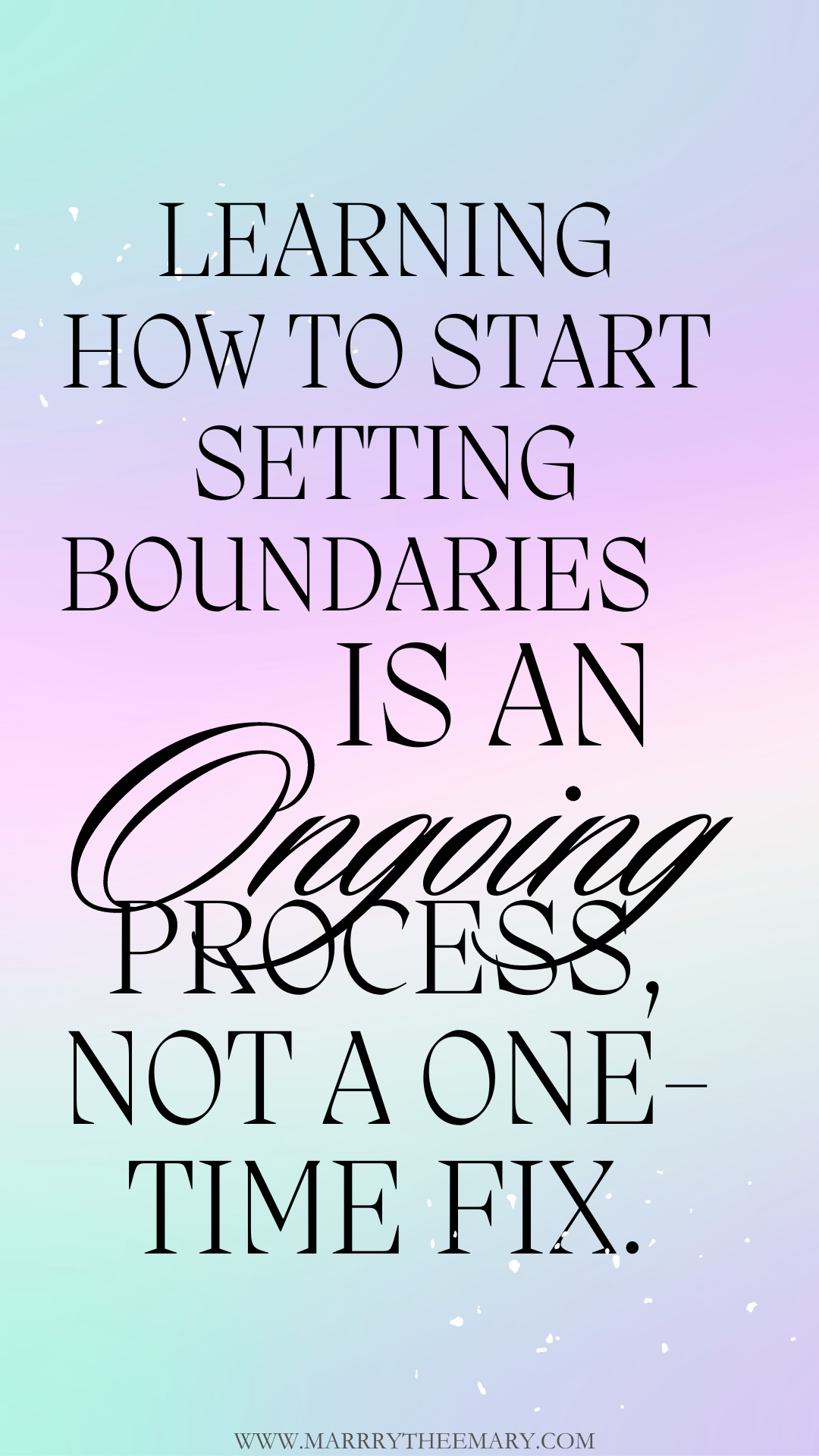Another year is almost here, and it feels like time is flying by. If you are looking to improve your mindset in 2024, setting boundaries is a great place to start. You need to learn how to start setting boundaries to welcome another fresh year with a positive attitude.

Let’s Talk Boundaries 101
Let’s get real for a sec. How many times have you found yourself overwhelmed with commitments that leave you feeling more drained than a phone on 1%?
You lose count, right? As we say goodbye to 2023 and look forward to 2024, it’s natural to reflect on the year that was and look ahead to what we want for the future. To clear your mind, it’s time to hit pause and ask yourself, “What do I really want my life to look like next year?”
Prioritizing the people and things that matter most to you is what setting boundaries is all about—not putting up walls.
However, setting boundaries can be difficult. There are moments when we are unsure of the boundaries we should establish. Sometimes, though, we are aware of what has to be done but are frightened to take action.
We draw boundaries to protect ourselves from being taken advantage of, abused, or just plain overwhelmed. They’re like a fence around our personal space, keeping out the things that we don’t want and keeping in the things that we do.
But boundaries can be tricky. Sometimes we don’t even know what boundaries we need to set. And other times, we know what we need to do, but we’re afraid to do it.
If you are struggling to establish boundaries, that is acceptable. You’re not alone. I’ve been there, too.
Confession Time
Let me admit something: I used to be a “yes” person. A people-pleaser, to be exact. I always say “yes” to extra work, yes to late-night calls, and yes to being the go-to problem solver.
However, guess what? I was feeling overwhelmed and exhausted, and I was afraid that I would eventually break down.
But eventually, I realized that my failure to establish boundaries was severely harming me. I was experiencing stress, resentment, and dissatisfaction.
So, I started to learn how to start setting boundaries. And you know what? It was hard at first. But it was also the best thing I’ve ever done for myself.
Tips on how to start setting boundaries
1. Learn to say no to things that do not support your values, your aspirations, or your love of late-night Netflix binges on Fridays.
I understand that it can be difficult to say no to people, especially if you’re used to always saying yes. But it’s important to remember that it’s okay to set boundaries and say no to things that you don’t have time to do. As a matter of fact, doing so is good for you.
When you always say yes, you’re putting a lot of pressure on yourself. You are trying to do too much and not giving yourself enough time to relax and recharge. This can result in burnout, stress, and even resentment.
However, by learning to say no, you are taking charge of your own time and energy. You’re saying to yourself, “I’m worth it. I deserve to have some time for myself.” And when you do this, you’re setting a healthy boundary that others will respect.
Here are some phrases you can use to start saying “no”:
2. Take some time to reflect on what your ‘Must-Haves,’ ‘Nice-to-Haves,’ and ‘No-Go Zones’ are.
The must-have, nice-to-have, and no-go zones are three important categories to consider when learning how to start setting boundaries.
Must-haves are the non-negotiable things that you need in order to feel safe, respected, and comfortable. These are the things that you will not compromise on and that you are willing to fight for.
Some examples of must-haves include:
Nice-to-haves are things that you would like to have but that you are willing to be flexible on. These are the things that would make your life better, but that you are not willing to fight for.
Some examples of nice-to-haves include:
No-go zones are things that you will not tolerate under any circumstances. These are the things that are unacceptable to you and that you will not stand for.
Some examples of no-go zones include:
- Being abused or mistreated
- Being disrespected
- Being lied to
- Being cheated on
It is important to note that everyone’s must-have, nice-to-have, and no-go zones will be different. What matters to one person may not matter to another. It is also important to remember that boundaries are not static; they can change over time as your needs and circumstances change.
3. Communicate your boundaries assertively and consistently.
Once you’ve identified your boundaries, it’s time to take the next step: communicating them clearly and directly to those involved. This might sound intimidating, but it’s crucial for establishing healthy relationships and protecting your well-being.
Think of it like drawing a line in the sand—you’re letting others know where your limits are and what you’re not comfortable with.
And to do this effectively, use “I” statements. Instead of saying, “You’re always interrupting me,” try, “I feel frustrated when I’m interrupted.” This approach shifts the focus to your feelings and needs, making it less accusatory and easier for others to understand and respect.
Remember, consistency is key. Enforcing your boundaries might require repetition and a firm “no” from time to time. Don’t be afraid to stand your ground. It’s okay to say, “I told you I wasn’t comfortable with that, and I’m asking you to stop.”
Learning how to start setting boundaries is an ongoing process, not a one-time fix. It requires self-awareness, communication skills, and the courage to prioritize your own well-being.
But trust me, it’s worth the effort. By establishing healthy boundaries, you’re protecting your energy, promoting respect in your relationships, and contributing to your overall happiness and well-being.
So, take that first step, identify your boundaries, and don’t be afraid to communicate them. It’s a journey towards self-respect, healthy relationships, and a happier you!
Wrap Up
As we’re about to turn the page to another year, it’s time to take a moment and realize how quickly time flies.
It’s also time to think about how we want our lives to look in 2024. Learning how to start setting boundaries is the key to saving your time, energy, and sanity in the coming year.
So, let’s embrace the challenge, learn to say no, define what we absolutely need and what we absolutely don’t, and communicate these boundaries clearly to create healthier relationships and pave the way for a happier and more fulfilling you in the year ahead.
Remember, it’s not about building walls around yourself; it’s about building bridges to a happier and healthier you.
Share your boundary-setting victories and challenges in the comments below. Let’s support each other as we embrace the power of saying “yes” to ourselves!
Explore marrytheemary.com for more self-care ideas and inspiration.




